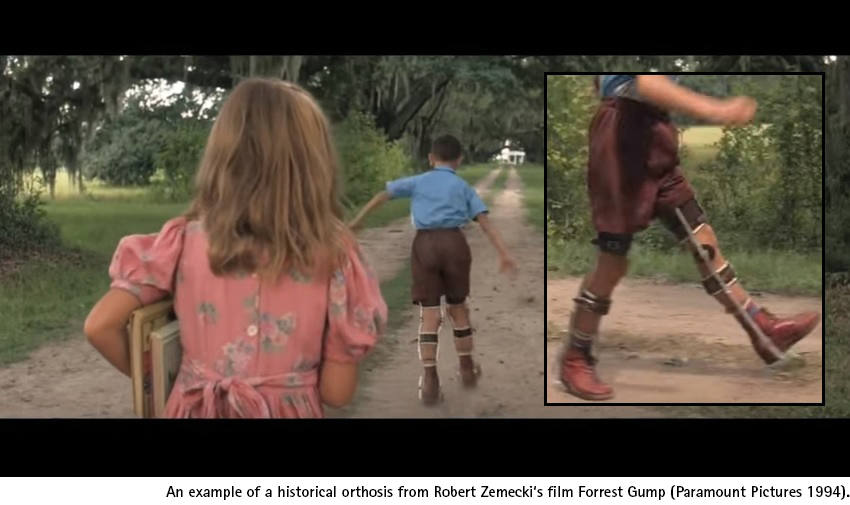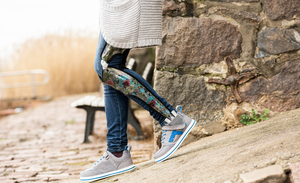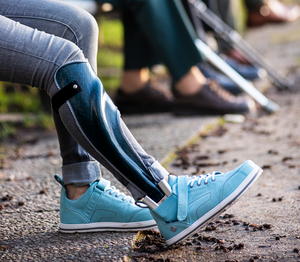Orthotics in the Field of Orthopaedic Technology
Orthopaedic technology differentiates between the two classic fields of prosthetics and orthotics. While a prosthesis replaces a body part, an orthosis supports a body part or body function.
In traditional orthotics, orthoses have a mere supporting function. They compensate lost mobility through stabilisation or secure and relieve pathologically affected areas. Common examples are ankle joint or knee orthoses after ligament ruptures.
Even for neurological indications with signs of paralyses of the lower extremities, the main focus of classic orthotics is still on the stabilising functions. One famous example for these orthoses for patients with paralyses is well-known from the film “Forrest Gump”. Sadly, this technological level still represents the prevalent form of treatment for patients with paralyses around the globe. The commonly used term “brace” for such an assistive device stands for this form of orthotic treatment and clearly shows that it simply only braces the leg and does not (re)activate the neurological or anatomical functions.
On a political level, the development of modern techniques for prostheses has been supported worldwide, especially during the major wars. The development of modern techniques in the field of orthotics on the other hand has never been the focus of public attention.
While “braces” due to their traditional technology, poor functionality and little individualisation have increasingly been replaced by wheelchairs, FIOR & GENTZ is vigorously dedicated to the field of individual neurological orthotics since its founding in 1997. The vast amount of different causes and manifestations of paralyses is what makes this field an exceptional challenge. FIOR & GENTZ has accepted this challenge and grown in the treatment of patients with paralyses over the past years.

New Treatment Concepts

Today, new treatment concepts for modern orthotics are provided, which no longer restrain the neurological and anatomical functions but support them. The fundamentally new approach is a combination of the classic stabilising function and a dynamic approach, which both posed contending therapy approaches for a long time. With this new approach, neurological functions are activated or reactivated, which result in physiological functions taking over anatomical structures.
FIOR & GENTZ specialises in the development of mechanical joints, which, with their technology as well as the related sensors and electronics, make the production of modern leg orthoses possible. The development of orthosis joints and related components is consistently oriented towards the approach of combining dynamic and stabilising features.
FIOR & GENTZ creates new concepts and production techniques for the construction of modern orthoses for patients with paralyses of the lower extremities, which are embedded into holistic treatment strategies. At the same time, FIOR & GENTZ aims to establish a new treatment standard for patients, enabling them to join in the social day-to-day life, by teaching orthotists and qualified/trained experts worldwide.
The Orthosis Configurator calculates the demands for each individually produced orthosis based on the neurological and anatomical requirements of the clinical picture. This planning tool was developed by FIOR & GENTZ and is available free of charge and in its entirety for all users with access to the internet. It creates a recommendation for the production of a custom-made leg orthosis, which exactly matches the patient’s demands.
Maintaining or restoring the ability to stand and walk is the most important task of orthotists or qualified/trained experts. This ability shall eliminate or reduce the patient’s dependence on a wheelchair, walker or crutches, so that they can use their hands freely to do everyday things while standing or walking.
Leg Orthoses in the Case of Paralyses
When producing modern leg orthoses for patients with neurological paralyses, it is important to know the paralysis category concerned:
- peripheral paralysis, e.g. poliomyelitis or multiple sclerosis (MS);
- spinal paralysis, e.g. caused by spina bifida or paraplegia;
- central paralysis, e.g. caused by a stroke or cerebral palsy.
In the case of peripheral paralyses, the muscle chains securing the main joints of the legs while standing and walking, operate only poorly. In spinal paralyses, they are not sufficiently supplied with impulses and in central paralyses, they are activated by the wrong impulses from the brain.
In peripheral and spinal paralyses, the focus is often on the support function providing security, whereas in central paralyses, the support function is used to reprogram physiological movement sequences in the brain. This is to improve the physiological activation of the muscles.
In many cases, patients affected by one of these three paralysis categories develop compensation mechanisms, which result in an atypical stance or gait. These mechanisms compensate lost stability while standing and walking. The patients fear to fall and use these gait patterns to join in everyday things of life without falling. This inevitably results in an increased wear of the joints, back pains and other physical troubles.
Some commonly seen examples demonstrate exactly that:
- A person with fully functional muscles uses the entire length of the feet to enlarge the stance area and thus keeping a stable balance while standing. The occurring lever forces are realised especially through the cooperation of the forefoot lever with the calf muscles. People with limited functionality of the calf muscles often display a forward bending of the torso while leaning on crutches or similar devices. In doing so, they artificially enlarge the supporting area on the ground. This is necessary for these patients, because their muscles cannot activate the forefoot lever, which is vital for standing upright.
- In many patients with paralyses, it can be observed that they rotate their feet inwards when they walk to protect their knees from the kinematic forces affecting the direction of movement, which would force the knee to give way.
- Some patients overextend the knee of their paralysed leg while standing and/or walking to protect the knee from giving way in flexion direction.
Especially in central paralyses, these compensation mechanisms are often passively caused and manifest as spasticities. In these cases, the brain unintentionally gives an impulse for an exaggerated security measure in exactly the moment when a signal is sent of the need for security.
The Goal of an Orthotic Treatment

A modern leg orthosis should always compensate lost muscular security in a way that is the least restrictive for the patient’s range of motion and provide the needed security by external forces at the same time. The required security is always at the centre of this constant balancing act.
In the field of orthotics, the ultimate treatment goal is a stable stance, which is achieved by supporting features.
The logical consequence from regained security through sufficient stability is a gait that is as physiological as possible. This can only be achieved if the dynamic features can be integrated into the orthosis without neglecting the supporting features. A physiological gait is the supreme discipline for modern leg orthotics. If a suitable combination for a patient has been found, secondary diseases, which are most commonly caused by the lack of motion and an unphysiological gait, can be prevented.

